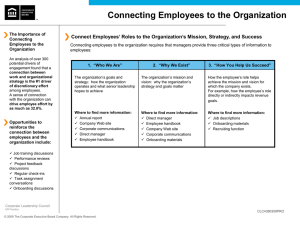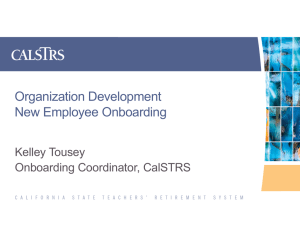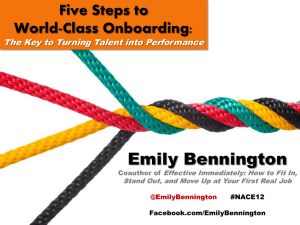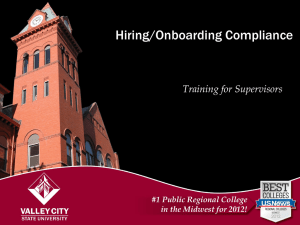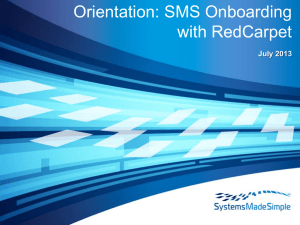Onboarding and Retaining New Executives
advertisement
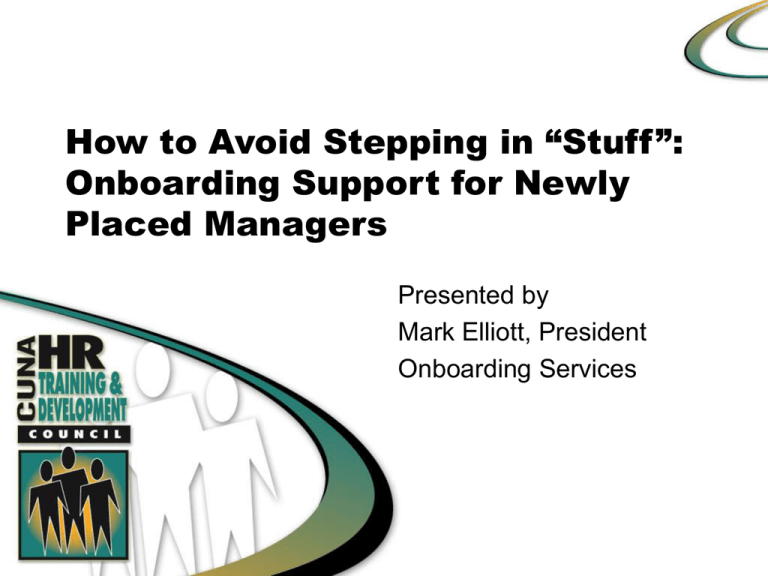
How to Avoid Stepping in “Stuff”: Onboarding Support for Newly Placed Managers Presented by Mark Elliott, President Onboarding Services Alarming Failure Rates ??% of new senior executives failed within 18 months ??% of CEO successors left company before succession Research data published studies by Harvard Business School, Manchester Partners International, and Center for Creative Leadership 2 Too Many Newly Placed Leaders are Stepping in “Stuff”! 3 Session Objectives Gain appreciation for the organizational problem and opportunity Understand challenges new managers and leaders face . . . and why Review proven onboarding process approaches and what HR/TD can and should do Take away specific implementation actions to help new leaders succeed 4 POP QUIZ When you have selected a new manager your work is done. True False 5 On´bōard·ing – the proactive, extended support process by which newly placed leaders successfully transition and integrate into their new roles and organizations 6 Why Onboarding Support is Needed Research identified 1st 3-4 months as most critical time for a new leader: Acquires organizational knowledge Builds key relationships Avoids missteps and mistakes Meets expectations Research data from published studies by Harvard Business School, Manchester Partners International, and Center for Creative Leadership 7 $$ Organizational Cost of Failure $$ Recruiting Compensation Training and development Termination Turnover of other staff members Mistakes Missed opportunities Damaged reputation/position 8 $$ Organizational Cost of Failure $$ Recruiting Compensation Training and development Termination Turnover of other staff members Mistakes Missed opportunities Damaged reputation/position 9 Why Does the Problem Exist? Bad recruitment and promotion decisions get made New leaders misread and misjudge the dynamics, expectations, and requirements of their new company and new role Companies fail to provide a structured process to aid new leaders 10 Why Does the Problem Exist? Bad recruitment and promotion decisions get made New leaders misread and misjudge the dynamics, expectations, and requirements of their new company and new role Companies fail to provide a structured process to aid new leaders 11 POP QUIZ A leader experienced in making transitions does not need onboarding support True False 12 POP QUIZ Promoting from within eliminates the need for onboarding support True False 13 Onboarding Realities Myths are not understood High expectations are everywhere Self-confidence blinds a newly placed executive New leader is juggling both organizational and personal transition Confidence creates false sense of security for the boss 14 Myths of Leadership Transition A leader experienced in making transitions has learned how to be successful and doesn’t need support. Promoted leaders already know the culture and have a support network. Therefore, they don’t need support. Sink or Swim approach is effective development 15 What Goes Wrong? How a new leader steps in “stuff” Not being clear on role, mandate, and mutual expectations Trying to do too much, too soon; being too heroic in expectations, ending up balancing too many simultaneous initiatives Failing to make the boss’s priorities a high priority Misreading (or not even trying to understand) company culture and style 16 What Goes Wrong? How a new leader steps in “stuff” Failing to understand before acting; coming in with “the answer” or jumping to it too quickly. Mismanaging the personal transition of family and new community. Not securing early wins; taking too long to make key changes and being sucked into the status quo. 17 Why Onboarding Support is Needed Research also identified: “Although all situations differ in their details, they all share common onboarding principles.” Research data from published studies by Harvard Business School, Manchester Partners International, and Center for Creative Leadership 18 How HR Contributes to the Problem Failure to assure good hiring & promotion decisions Not making the business case on costs Not creating/providing onboarding process Source: The Conference Board Report – “Sustaining the Talent Quest” 19 The Solution Avoid Stepping in “Stuff”: Protect Your Investment Hire or promote someone with the leadership skills to address CU’s needs; with the style to fit your culture Attack myth-based actions Capture that person’s potential by providing new leader onboarding support 20 On´bōard·ing – the proactive, extended support process by which newly placed leaders successfully transition and integrate into their new roles and organizations 21 Onboarding: A New Term, But Not a New Topic In the past 25 years dozens of books and research reports have been published on leadership Transition, Assimilation, and Integration You’re In Charge—Now What? – 2005 The First 90 Days – 2003 Assimilating New Leaders – 2001 Right From the Start – 1999 Preventing Derailment – 1995 Organizational Entry and Assimilation – 1987 The Dynamics of Taking Charge – 1987 When a New Manager Takes Charge – 1985 Why and How Successful Executives Get Derailed – 1983 22 The Solution The goal of onboarding is the acceleration of the newly placed leader’s effectiveness and contribution 23 The Solution The goal of onboarding is the acceleration of the newly placed leader’s effectiveness and contribution and avoiding the organizational risk of failure 24 POP QUIZ Most CUs provide more orientation, training, and support to new tellers than they do to newly placed leaders. True False 25 The Solution Provide 3-4 months of support to prevent what goes wrong . . . and stepping in “stuff” Areas of Focus: Acquiring organizational knowledge Identifying key stakeholders & building relationships Avoiding missteps and mistakes Achieving early performance expectations 26 Sports Model Components: 27 Comprehensive Support Process Onboarding Components: Process Map Specialized Coaching Tools Leadership Skills Development Practice with Actual Work Situations 28 Onboarding Process Map (A partial list of linear steps) Pre-Start Start Three-Months Six-Months Clarify your role and agree with boss on expectations Gather information and develop insight into organization dynamics Identify a few significant early wins to create momentum Build relationships with key stakeholders Begin to build your high-performance team Develop your 90-Day Plan 29 Coaching Tool: New Leader’s Onboarding Start To-Do’s Don’t act like you know everything Ask questions instead of giving answers Learn the leadership practices and culture Identify and develop key relationships Make your boss’s priorities your priority Set reasonable expectations Go SLOW! So you can go fast 30 Coaching Tool: Boss’s To-Do’s in Support of New Leader Provide counsel on leadership practices and culture Develop “How-To-Manage-Me” guide Assist new leader with the development of his/her 30and 90-day plans Encourage/support reasonable expectations Give continuing priority (4-6 mos.) to the onboarding process 31 Leadership Skills Development The interpersonal and process skills critical to onboarding success Managing the boss relationship Getting-started communications Developing a high-performance team Win/win negotiation and problem solving Introducing change Coaching for improved performance 32 Benefits of Comprehensive Onboarding Process Positions new leaders for success Accelerates learning, performance, and impact Prevents avoidable management turnover and related costs Enhances ability to manage business challenges and capitalize on business opportunities 33 Contact Mark Elliott: melliott@onboardingservices.com www.powerstartonboarding.com 34
